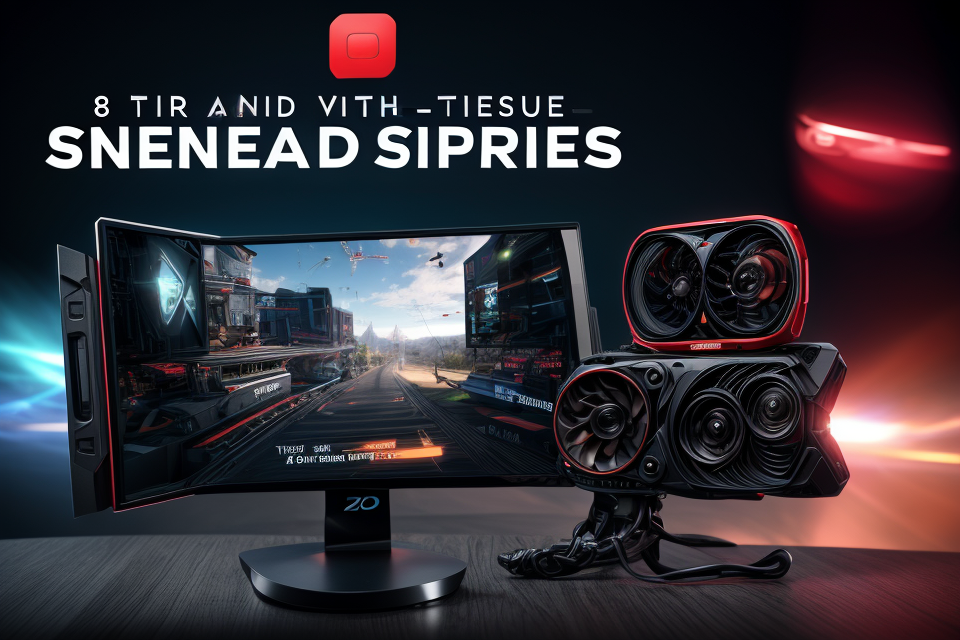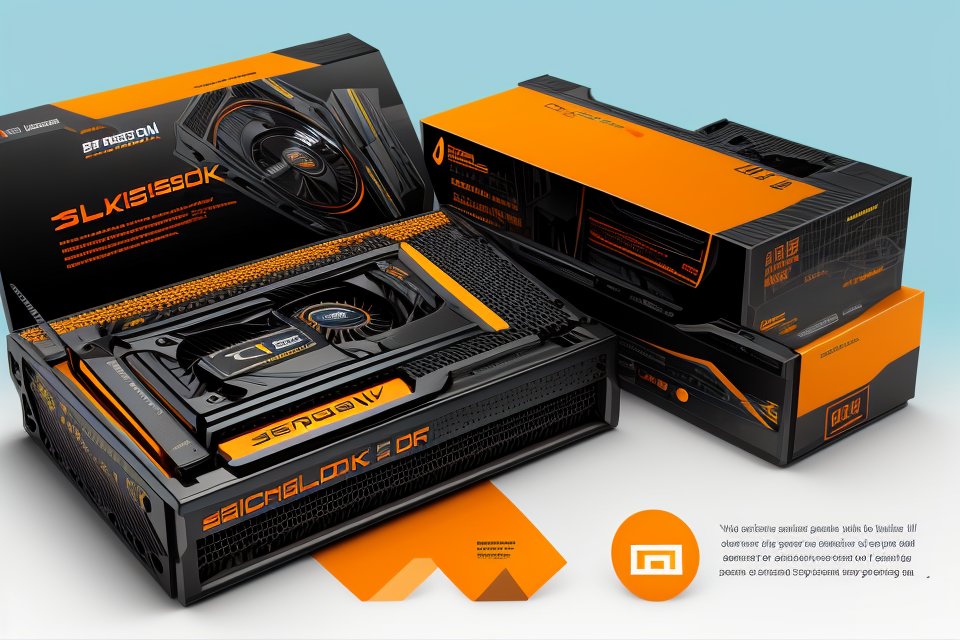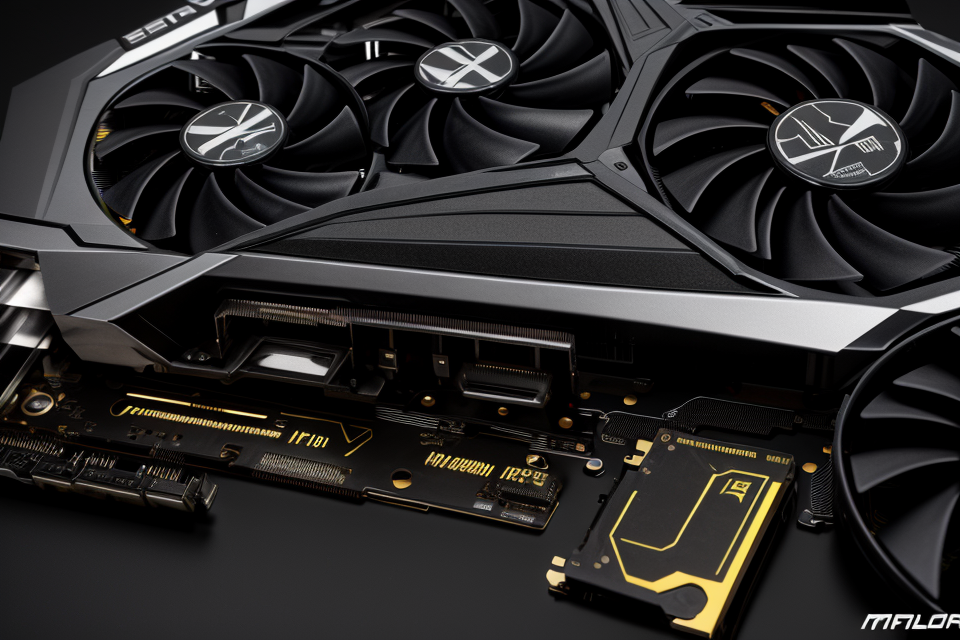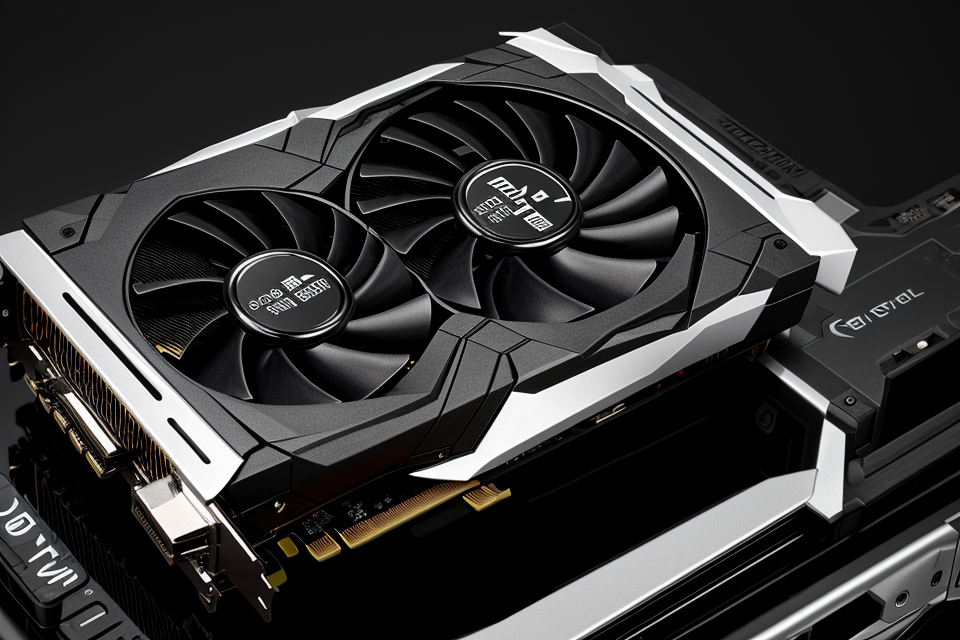
If you’re a gamer, then you already know the importance of having a high-end graphics card. But for those who aren’t familiar with the world of gaming, let me explain. A graphics card, also known as a GPU (Graphics Processing Unit), is a component in your computer that is responsible for rendering images and video. It’s what makes your games look good, run smoothly, and allows for features like anti-aliasing and shadows. But having a high-end graphics card isn’t just for gamers. It can also benefit those who work in fields like video editing, 3D modeling, and graphic design. In this article, we’ll explore the benefits of having a high-end graphics card and why it’s worth the investment.
Having a high-end graphics card can provide several benefits. One of the most obvious is improved performance in graphics-intensive applications such as gaming, video editing, and 3D modeling. A high-end graphics card can also enable features such as higher resolutions, better lighting, and more realistic textures, resulting in a more immersive experience. Additionally, a high-end graphics card can help reduce the load on the CPU, resulting in better overall system performance. Finally, a high-end graphics card can make your system more future-proof, allowing you to take advantage of new technologies and applications as they become available.
What is a Graphics Card?
The Basic Functions of a Graphics Card
A graphics card, also known as a video card or display card, is a hardware component that is responsible for rendering images and videos on a computer screen. It is a critical component for users who engage in tasks that require high-quality graphics, such as gaming, video editing, and graphic design.
The basic functions of a graphics card include:
- Image Processing: The graphics card is responsible for processing and rendering images, which includes converting pixels into real-world objects and applying lighting effects, shadows, and reflections.
- Video Decoding: The graphics card can also assist in decoding video content, offloading the work from the CPU. This is particularly important for tasks such as video editing and playback.
- 3D Rendering: The graphics card is specifically designed to handle complex 3D graphics, which is crucial for tasks such as gaming and 3D modeling. The graphics card must be able to process and render complex geometry, textures, and lighting effects in real-time.
- GPU Acceleration: Some applications, such as scientific simulations and cryptocurrency mining, can take advantage of the processing power of the graphics card. These applications can use the GPU to perform complex calculations, offloading the work from the CPU and improving overall performance.
Overall, the graphics card plays a critical role in the performance of a computer, particularly for tasks that require high-quality graphics. In the next section, we will explore the benefits of having a high-end graphics card.
How Graphics Cards Enhance Gaming Experience
A graphics card, also known as a video card or display card, is a hardware component that is responsible for rendering images and videos on a computer screen. It is designed to process and display high-quality visuals in real-time, making it an essential component for gaming.
High-end graphics cards offer several benefits to gamers, including improved graphics quality, smoother gameplay, and faster frame rates. Here are some of the ways that graphics cards enhance the gaming experience:
- Higher Frame Rates:
Graphics cards are responsible for rendering frames in a game, and a high-end graphics card can render frames at a higher rate than a low-end card. This means that the game will run smoothly, with fewer dropped frames and stutters. Higher frame rates are particularly important in fast-paced games, where even a small delay can make a big difference. - Improved Graphics Quality:
A high-end graphics card can handle more complex graphics and textures than a low-end card. This means that gamers can enjoy richer, more detailed graphics, with smoother lighting and shadows, more realistic textures, and more advanced special effects. These enhanced graphics can significantly improve the overall gaming experience, making it more immersive and engaging. - Faster Load Times:
In addition to rendering frames during gameplay, graphics cards are also responsible for loading game assets, such as textures, models, and sound files. A high-end graphics card can load these assets faster than a low-end card, reducing the amount of time that gamers spend waiting for the game to load. This can be particularly noticeable in large, open-world games, where load times can be significant. - VR Ready:
Many high-end graphics cards are designed to be VR-ready, meaning they can handle the demands of virtual reality gaming. VR games require a high level of graphics processing power, and a high-end graphics card can deliver the necessary performance to run these games smoothly. This can provide a more immersive and realistic gaming experience, with more detailed and realistic graphics.
Overall, a high-end graphics card can greatly enhance the gaming experience by providing smoother gameplay, faster frame rates, improved graphics quality, and faster load times. These benefits can make a significant difference in the overall gaming experience, particularly for gamers who enjoy fast-paced, graphics-intensive games.
The Advantages of Having a High-End Graphics Card
Improved Gaming Performance
Having a high-end graphics card can significantly improve the gaming performance of your computer. This is because these cards are designed to handle the demands of modern video games, which often require powerful graphics processing capabilities. Here are some specific ways in which a high-end graphics card can enhance your gaming experience:
Increased Frame Rates
One of the most noticeable benefits of having a high-end graphics card is that it can increase the frame rates of your games. Frame rate refers to the number of images that are displayed per second, and a higher frame rate generally results in smoother, more fluid gameplay. High-end graphics cards are capable of rendering frames at a much faster rate than lower-end cards, which means that you’ll experience less lag and more seamless gameplay.
Enhanced Visual Quality
In addition to higher frame rates, a high-end graphics card can also enhance the visual quality of your games. This is because these cards are equipped with more powerful graphics processing units (GPUs) that are capable of rendering more complex textures, shaders, and other visual effects. As a result, you’ll be able to experience games with more detailed and realistic graphics, which can greatly enhance your overall gaming experience.
Support for Higher Resolutions
Another benefit of having a high-end graphics card is that it can support higher resolutions. Resolution refers to the number of pixels that are displayed on the screen, and higher resolutions generally result in sharper, more detailed images. Many high-end graphics cards are capable of supporting resolutions of 4K or even 8K, which means that you’ll be able to experience games with much higher levels of detail and clarity.
Improved Performance in Demanding Games
Finally, a high-end graphics card can provide improved performance in demanding games. Many modern games require a significant amount of processing power to run smoothly, and a high-end graphics card can provide the necessary processing power to handle these demands. This means that you’ll be able to play demanding games at higher settings and resolutions, which can greatly enhance your overall gaming experience.
Better Rendering and Visual Quality
A high-end graphics card offers a significant advantage when it comes to rendering and visual quality. Here are some of the key benefits of having a powerful graphics card:
Faster Rendering Times
One of the most significant advantages of having a high-end graphics card is that it can significantly reduce rendering times. This is particularly important for professionals who work with large datasets or need to render complex 3D models. With a powerful graphics card, you can quickly and efficiently process large amounts of data, allowing you to work more efficiently and meet tight deadlines.
Smoother Animations
Another benefit of having a high-end graphics card is that it can help create smoother animations. This is particularly important for video editing and animation software, where even small changes in frame rate can make a big difference in the final product. With a powerful graphics card, you can create smoother animations that look more natural and realistic.
Higher Resolution and More Detail
A high-end graphics card can also help you achieve higher resolution and more detail in your work. This is particularly important for graphic designers, video editors, and other professionals who work with high-resolution images and videos. With a powerful graphics card, you can handle larger files and work with higher resolutions, allowing you to create more detailed and accurate work.
Improved Visual Quality
Finally, a high-end graphics card can help you achieve improved visual quality in your work. This is particularly important for gamers and other users who demand the highest levels of visual fidelity. With a powerful graphics card, you can enjoy smoother frame rates, more realistic textures, and more vibrant colors, all of which contribute to a more immersive and enjoyable experience.
Increased Efficiency in Video Editing and 3D Modeling
One of the most significant advantages of having a high-end graphics card is the increased efficiency in video editing and 3D modeling. This is because these tasks require a significant amount of processing power, and a high-end graphics card can provide the necessary horsepower to handle them smoothly.
Here are some of the benefits of having a high-end graphics card for video editing and 3D modeling:
Reduced Rendering Times
One of the most significant benefits of having a high-end graphics card is the reduced rendering times. Rendering is the process of generating a 2D image or animation from a 3D model. This process can be very time-consuming, especially for complex 3D models with many objects and textures. With a high-end graphics card, however, the rendering process can be significantly sped up, allowing you to work more efficiently and complete projects faster.
Smoother Playback and Previewing
Another benefit of having a high-end graphics card is the smoother playback and previewing of video and 3D models. This is because a high-end graphics card can handle more complex graphics and animations, which means that you can preview your work more smoothly and make changes more easily. This can be especially useful when working with large video files or complex 3D models with many moving parts.
Improved Performance in GPU-Accelerated Applications
Finally, a high-end graphics card can also improve performance in GPU-accelerated applications. These are applications that use the graphics processing unit (GPU) to perform tasks that would normally be handled by the central processing unit (CPU). Examples of GPU-accelerated applications include scientific simulations, data analysis, and machine learning. With a high-end graphics card, these applications can run more smoothly and efficiently, allowing you to work more effectively and complete projects faster.
Overall, having a high-end graphics card can provide significant benefits for video editing and 3D modeling. Whether you’re working on a complex 3D model or editing a large video file, a high-end graphics card can help you work more efficiently and complete projects faster.
Choosing the Right Graphics Card for Your Needs
Factors to Consider When Selecting a Graphics Card
When it comes to selecting a graphics card, there are several factors to consider to ensure that you choose the right one for your needs. These factors include:
- Budget: One of the most important factors to consider is your budget. Graphics cards can range from affordable options to high-end models that can cost several hundred dollars. Determine how much you are willing to spend and look for options within that price range.
- Performance: Another important factor to consider is the performance of the graphics card. High-end graphics cards typically offer better performance than entry-level models, which can be particularly important if you use your computer for tasks such as gaming, video editing, or graphic design. Consider the specific tasks you will be using your computer for and look for a graphics card that can handle them.
- Compatibility: It is also important to consider compatibility when selecting a graphics card. Make sure that the graphics card you choose is compatible with your computer’s motherboard and power supply. Additionally, check to see if the graphics card is compatible with the software you plan to use.
- Size: The size of the graphics card can also be a factor to consider. Some graphics cards are larger and may not fit in smaller cases. Make sure to measure the size of the graphics card and compare it to the size of your computer case to ensure that it will fit.
- Cooling: Graphics cards generate a lot of heat, and it is important to make sure that the graphics card you choose has adequate cooling. Look for graphics cards with efficient cooling systems, such as fans or liquid cooling, to ensure that the card stays cool during use.
By considering these factors, you can ensure that you choose the right graphics card for your needs and get the most out of your investment.
Recommended Graphics Cards for Different Budgets and Usage
When it comes to choosing the right graphics card for your needs, it’s important to consider your budget and the specific usage of the card. Here are some recommended graphics cards for different budgets and usage scenarios:
Budget: $0-$300
- Nvidia GTX 1650 Super
- AMD Radeon RX 5600 XT
Budget: $300-$500
- Nvidia GTX 1660 Super
- AMD Radeon RX 5700
Budget: $500-$700
- Nvidia RTX 2060
- AMD Radeon RX 5700 XT
Budget: $700-$1000
- Nvidia RTX 2070
- AMD Radeon RX 6700 XT
Budget: $1000+
- Nvidia RTX 3070
- AMD Radeon RX 6800 XT
It’s important to note that these are just recommendations and the best graphics card for you will depend on your specific needs and usage. If you’re a gamer, you’ll want to prioritize a card with high frame rates and fast refresh rates. If you’re a content creator, you’ll want to prioritize a card with high resolution and color accuracy. Additionally, it’s important to check the compatibility of the graphics card with your computer’s motherboard and power supply before making a purchase.
Recap of the Benefits of Having a High-End Graphics Card
A high-end graphics card offers several benefits for users, making it a worthwhile investment for those looking to improve their gaming or multimedia experience. Some of the key benefits of having a high-end graphics card include:
- Faster Frame Rates: A high-end graphics card can significantly improve the frame rates of your games, resulting in smoother and more responsive gameplay. This is especially important for fast-paced games that require quick reflexes, as even a small improvement in frame rates can make a big difference.
- Improved Visual Quality: High-end graphics cards are capable of rendering more detailed and complex graphics than lower-end models. This means that you can enjoy games and multimedia content with higher resolutions, more detailed textures, and better lighting effects.
- Increased Performance: High-end graphics cards are designed to handle demanding workloads, such as running multiple applications or editing high-resolution video. This means that you can run more demanding software without experiencing performance issues, allowing you to be more productive and efficient.
- Future-Proofing: High-end graphics cards are built to last, and investing in one can help future-proof your system. As technology continues to advance, your high-end graphics card will be able to handle the demands of new software and games, ensuring that your system stays up-to-date and relevant.
When choosing a high-end graphics card, it’s important to consider your specific needs and budget. Do some research to determine which graphics card is the best fit for your system and your budget, and consider factors such as performance, price, and compatibility with your other hardware.
Final Thoughts and Recommendations
When it comes to choosing the right graphics card for your needs, there are several factors to consider. First and foremost, you need to assess your budget and determine how much you are willing to spend on a high-end graphics card. Keep in mind that the price of a graphics card can vary widely depending on its performance, features, and compatibility with your computer’s motherboard and power supply.
Once you have established your budget, you need to consider the specific tasks and applications that you will be using your graphics card for. For example, if you are a gamer, you will want to look for a graphics card that offers high frame rates and smooth gameplay. On the other hand, if you are a content creator or designer, you may be more interested in a graphics card that offers advanced features such as real-time ray tracing or AI acceleration.
Another important factor to consider is the size and form factor of the graphics card. Some high-end graphics cards can be quite large and require additional power connectors, while others are smaller and more power-efficient. You should also consider the cooling solution used by the graphics card, as some may require more noise-cancelling features or larger fans.
Finally, you should also take into account the reputation and track record of the manufacturer when choosing a graphics card. Some brands are known for producing high-quality and reliable products, while others may have a history of issues with compatibility or performance.
In conclusion, choosing the right graphics card for your needs requires careful consideration of several factors, including budget, performance requirements, size and form factor, cooling solution, and brand reputation. By taking the time to assess these factors, you can find a high-end graphics card that meets your needs and helps you achieve your goals, whether they are gaming, content creation, or something else entirely.
FAQs
1. What is a graphics card?
A graphics card, also known as a video card or display card, is a hardware component that is responsible for rendering images and videos on a computer screen. It is an essential component for tasks such as gaming, video editing, and graphic design.
2. What is the difference between a high-end graphics card and a low-end graphics card?
A high-end graphics card has more powerful processing capabilities than a low-end graphics card. It can handle more complex tasks, such as rendering high-resolution images and videos, and can support features such as real-time ray tracing and artificial intelligence. Low-end graphics cards, on the other hand, are designed for basic tasks such as web browsing and office applications.
3. What are the benefits of having a high-end graphics card?
There are several benefits to having a high-end graphics card, including:
* Improved performance: A high-end graphics card can handle more demanding tasks and can render images and videos at higher resolutions and frame rates.
* Enhanced visual quality: High-end graphics cards can support features such as real-time ray tracing and HDR (high dynamic range), which can greatly enhance the visual quality of images and videos.
* Increased reliability: High-end graphics cards are built with higher-quality components and are designed to be more reliable than low-end graphics cards.
* Future-proofing: A high-end graphics card can help ensure that your computer is able to handle the demands of future software and games.
4. Do I need a high-end graphics card for everyday tasks?
A high-end graphics card is not necessary for everyday tasks such as web browsing, office applications, and video streaming. A low-end or mid-range graphics card will suffice for these tasks. However, if you are planning to use your computer for tasks such as gaming, video editing, or graphic design, a high-end graphics card would be beneficial.
5. How do I know if my computer needs a new graphics card?
If your computer is experiencing slow performance, crashing, or freezing during graphics-intensive tasks, it may be an indication that your graphics card is failing or is no longer able to handle the demands of your software or games. In this case, upgrading to a high-end graphics card may improve your computer’s performance.


